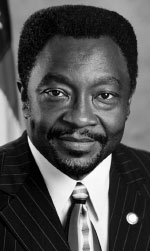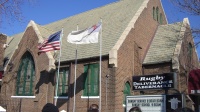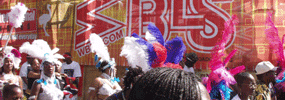Political Involvement and Community Centers
From Seminar 2: The Peopling of New York City
Contents |
Introduction
Politics and community centers play a central role in community development. Politicians, for example, push for certain legislation that benefit their communities specifically, and secure funding for programs in their neighborhoods. Community centers provide a place where children can study and learn about their culture.
Like many immigrant communities, community development is fueled by one thing--Transnationalism, a big word defined as "a process by which immigrants forge and sustain simultaneous multi-stranded social relations that link together their societies of origin and settlements" (Basch 48). Essentially, migration occurs because of the ever-changing global economy. People from different countries move in search of better jobs and more stable working environments.
Transnationalism
Transnationalism is nothing new to New York City. Politically active West Indian migrants are seen as early as the 1920s with Marcus Garvey, a Caribbean native (Kasinitz 113). Throughout the rest of the 20th century, with the political instability in the Caribbeans, New York West Indians got increasingly involved in the political processes abroad. It was not uncommon to see West Indians in New York traveling to their home countries to campaign for a particular candidate and it was common practice for Caribbean politicians to campaign in New York as well. One example of the fervor transnational politics lies in the murder of a New York Haitian journalist named Firmin Joseph, who was an outspoken opponent of the Duvalier-regime. His criticisms ultimately led to his death at the hands of Duvalier supporters in the city.
Another major reason for transnationalist ties is the economic factor. As previously mentioned, many West Indian leaders come to New York to raise support and funds for their campaigns. But more importantly, migrants who settle in the city often send back remittances and goods to their home countries. For many Caribbean countries, which lack stable economies, this represents a significant portion of their national income. The money is often invested in various Caribbean community development projects.
West Indian Political Identity and Its Impact on Community Development
West Indians in New York have had a particularly hard time forming their own political identities. This is a result of the racist notions of Americans. For many Americans, West Indians are lumped together with the overall category of "Black". They are often mistakened to be Black Americans. The only distinguishing factor for many Americans is the accents, which in the past was characteristic of West Indian migrants. However, as generations pass, more and more children are being born and raised in New York, resulting in the loss of the accent.
This is especially undesirable to West Indians due to the race issue--Black Americans are discriminated against all the time. One West Indian student mentions how the police questioned him right after a shooting solely because he was Black (Lopez 73). To avoid the social stigma of being Black, many West Indians chose to take on a West Indian social identity--especially in the past, they disliked being associated with Black Americans. Political unification between West Indian communities and Black communities was particularly difficult because of this mind set.
During the 1960s, West Indians became increasingly active in politics. Many political organizations began to sprout up--one of the more active groups, the National Organization of West Indian Americans, rigorously promoted voter registration drives and through their efforts managed to push Caribbean leaders such as Shirley Chisolm as far as the democratic primaries for Presidency (Claye). Many West Indian political leaders have taken office today, with Councilman Mathieu Eugene, Assemblyman Nick Perry, and Congresswoman Yvette Clark being a few of them.
In the more recent years, there has been more attempts at Pan-African unification. Many leaders, Black and West Indian alike realize the necessity to unify each ethnic group under one banner. Jesse Jackson, a Black Presidential Candidate serves as an early example--he actively campaigned in Flatbush to gain the support of the West Indian voters. Upon his first visit, he failed to captivate his audience because he failed to discuss West Indian related issues (Kasinitz 155). This proved to be a huge mistake as many in the community was outraged.
Many current West Indian leaders are now pushing for the same legislation as Black American leaders. For example, Assemblyman Perry and Congresswoman Clark both supported a bill that prohibited arrests based solely on racial profiling. Normally, this could be applied to any ethnic group. But, Blacks have a history of facing racial profiling and harassment by law enforcement. Referring back to the American perspective of West Indians, which groups them with Black Americans, we see that there is a sort of unification on this issue. These politicians, despite their West Indian backgrounds, are taking on a Black American political identity and merging into a unified political force.
The West Indian politicians have supported numerous bills that are particular to the Flatbush community. Assemblyman Perry, for example, has supported a bill that allows the issuance of a temporary Carnival permit to sell alcohol (Carnival is a very important annual West Indian tradition that displays elaborate hand-made costumes; before the NYC ban on alcohol in Carnival, alcohol-manufacturing companies sponsored these events), as well as secured funding for several West Indian studies and libraries in the CUNY system. Other leaders like Councilman Eugene has promoted a healthier Flatbush, supporting youth fitness programs and universal health care for the New York City. One of the churches we visited provided a family center, funded by the City Council of New York.
Community Centers
Community centers play a crucial role in Flatbush. For starters, they provide help to the less fortunate and new migrants who may not be familiar to the city or to the English language. The Rugby Tabernacle, a religious institution provides free meals and a free family center that helps immigrants and families through counseling and other various activities.
Youth centers in Flatbush provide more than just a safe environment for children--they are also a place of cultural learning. As more and more generations grow up in New York, they begin to lose their sense of cultural identity. That was the mindset of the founders of Sesame Flyers International, who opened up the youth center to teach younger generations about the cultural aspects of the Caribbean. They participate in the annual Carnival, for example, which is a truly authentic Caribbean tradition. Each year, many West Indian organizations such as Sesame Flyers reveal elaborate costumes that took them weeks to create to be judged. They even bring Trinidadians to New York to help with the costume-making. Additionally, they provide hard-working immigrant parents a place to send their kids there while they are working. The founder described Sesame Flyers as a free babysitting place.
Conclusion
Transnationalist ties are prevalent in almost every aspect of Community Development in Flatbush. Politically, West Indians living in New York are extremely active both in New York City and at home,Community centers, likewise have seen thneir share of transnatioalism. From places like Rugby Tabernacle, which helps newly-arrived West immigrants, to youth centers like Sesame Flyers, which promotes the Caribbean culture through events like Carnival, culture is deeply ingrained these centers. Ultimately, for the West Indian residents of Flatbush, there is a duality--on the one hand they are "Americanizing", but on the other they try hard to maintain their own Caribbean identity.
Works Cited
- Claye, Charlene. An Introduction to the Black Contribution to the Development of Brooklyn, U.S.A.: New Muse Community Museum of Brooklyn, 1977.
- Lopez, Nancy. 2002. "Race-Gender Experiences and Schooling: Second-Generation Dominican, West Indian, and Haitian Youth in New York City". Race Ethnicity and Education, Vol. 5, No. 1:67-89
- Glick Schiller, Nina; Linda Basch; Cristina, Szanton Blanc, 1995. "From Immigrant to Transmigratn; Theorizing Transnational Migrants". Anthropological Quarterly Vol. 68, No. 1:48-63
- Foner, Nancy. Islands in the City: West Indian Migration to New York. Berkeley: University of California, Ltd, 2001.
- Kasinitz, Philip. Caribbean New York: Black Immigrants and the Politics of Race. Ithaca: Cornell University Press, 1992.
- Sisk, Richard. "Haitian dissident slain." Daily News September 23 (1983).
- Perry, Nick. "Reports to the People Holiday 2007." Assemblyman Nick Perry. 2 May 2008 <http://assembly.state.ny.us/member_files/058/20061212/>.
- "Sesame Flyers International Photo Gallery." Sesame Flyers International Incorporated. Sesame Flyers International Incorporated. 2 May 2008 <http://www.sesameflyers.org/main.htm>.


